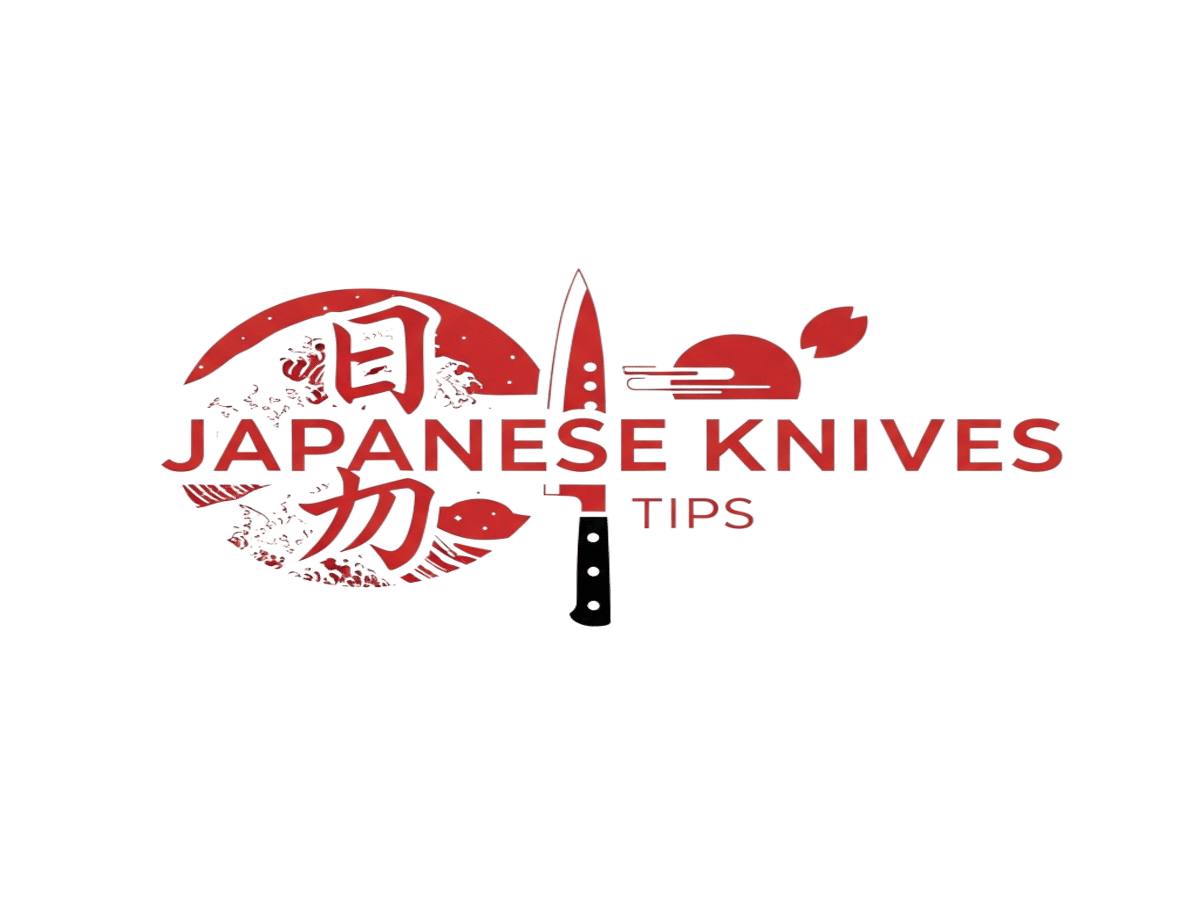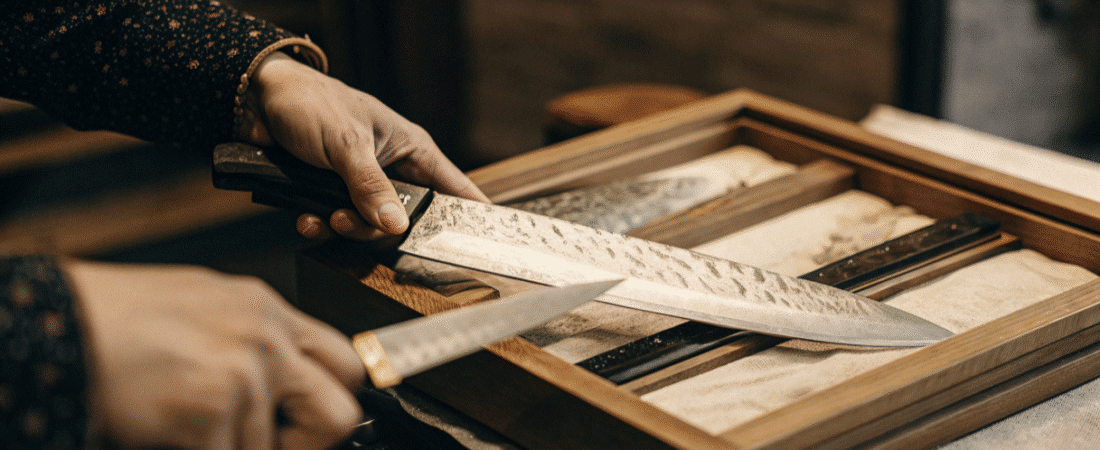Masamoto is a name that pops up often when talking about top-quality Japanese knives. Surely you must have heard the name Masamoto at least once, even if you are not a professional chef, thanks to its widespread reputation. If you’ve ever wondered why professional chefs swear by these tools, you’re in the right place. Masamoto Sohonten has been making traditional Japanese knives for over 150 years, and their reputation is built on solid craftsmanship and sharp performance. Whether you’re slicing sushi or chopping veggies, these knives are designed to get the job done with precision and ease.
- The History Behind Masamoto
- What Makes Masamoto Knives Stand Out?
- How the Craftsmanship Comes Together
- Using Masamoto Knives in Your Kitchen
- Cutting Techniques and Surface
- Caring for Your Masamoto Knife
- The Masamoto KS Series: A Closer Look
- Why Chefs Choose Masamoto
- Tips for Getting the Most Out of Your Masamoto Knife
- Where to Buy and Personalize Your Masamoto Knife
- Final Thoughts on Masamoto Knives
- FAQs
The History Behind Masamoto
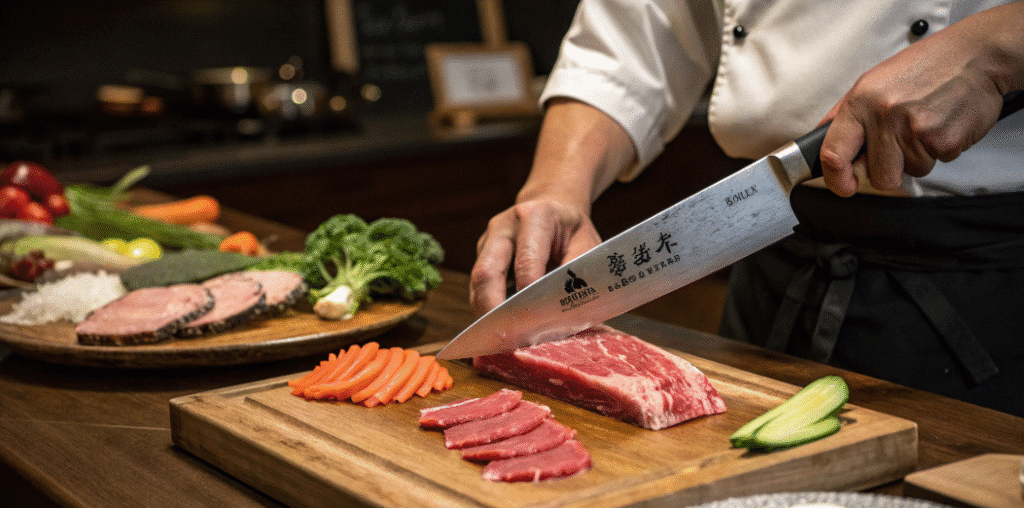
Minosuke Matsuzawa, the founder of Masamoto, was born in 1845. The story starts with his early dedication to the craft of knife making. He spent decades traveling, learning, and perfecting his skills. His goal was simple: make the best knives that chefs would trust for generations. Five generations later, Masamoto still holds that promise. The company is based in Tokyo, where tradition meets skill, and their knives carry a mark of excellence that’s hard to beat.
What Makes Masamoto Knives Stand Out?
Masamoto knives are made with high-grade white steel, known for holding a sharp edge longer than many other types of steel. Masamoto also uses high carbon steel in some of their knives, which is prized for its ease of sharpening and its ability to develop a patina over time, adding character and helping to enhance food flavor. The KS series, in particular, is a favorite among chefs who want a blade that’s both tough and easy to handle. The full tang design means the blade runs through the handle, giving the knife better balance and strength. This makes cutting feel natural and reduces hand fatigue during long cooking sessions.
The blade’s sharpness is no joke. Thanks to the careful forging and polishing process, these knives slice through meat, fish, and vegetables with little effort. The edge is extremely sharp but also durable, so it won’t dull quickly. If you want a knife that feels lighter in your hand but still packs a punch, Masamoto’s design hits the mark.
How the Craftsmanship Comes Together
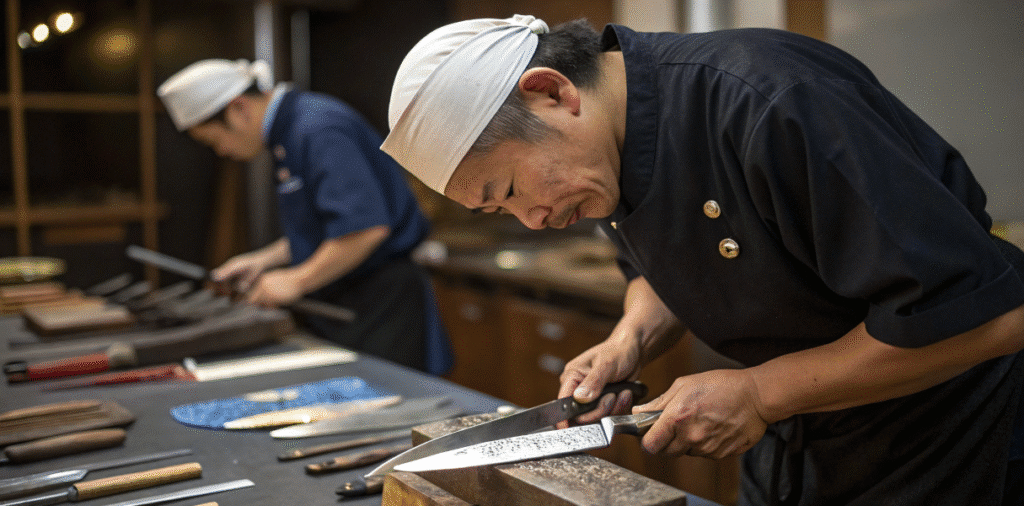
Making a Masamoto knife isn’t just about steel and shape. It’s about the hands that shape the steel. Skilled craftsmen use traditional methods passed down through generations. The forging process heats and shapes the steel to form a strong, resilient blade. Then comes the polishing and sharpening, which turn the blade into a precise cutting tool.
This finishing stage is where the knife gets its signature polished look and razor-sharp edge. The attention to detail here is what sets Masamoto apart from other knives on the market. You can almost feel the sense of care in every cut you make with one of these knives.
Using Masamoto Knives in Your Kitchen
Masamoto knives work well for a variety of tasks. Whether you’re peeling fruits, chopping vegetables, or slicing sashimi, these knives handle it all. Their sharp edge and balanced feel make cutting, chopping, and peeling a variety of ingredients efficient and easy. The blade’s design is meant to glide through ingredients without crushing or tearing them, which helps keep the taste and texture intact. Using a Masamoto knife allows you to prepare delicious food and enhances the presentation of Japanese cuisine by making it easier to work with seasonal ingredients.
If you’re working with hard ingredients like meat or tougher vegetables, the durable edge of a Masamoto knife shines. It holds up well against tougher cutting surfaces and doesn’t lose its sharpness quickly. Just remember to use a proper cutting board—wood or plastic boards are best—to keep the blade in good shape.
Cutting Techniques and Surface
Want to get the most out of your Japanese knife?
Especially a Masamoto KS?
You need the right cutting techniques.
You need the proper cutting surface.
These are key.
Professional chefs love Japanese knives. Celebrity chefs do too. Why? They have extremely sharp edges. They are durable. The high-carbon white steel makes them special. Expert craftsmanship goes into every blade. But even the best knife needs the right handling. That’s how it truly shines.
The cutting surface matters a lot.
It can make a world of difference.
Use a quality wood board. Or try a high-end composite board. These help protect the edge. They keep your Masamoto knife sharp. They keep it ready for action. Japanese knives are different from other knives. Masamoto Sohonten designs them with a refined edge. Hard surfaces can hurt them. Glass surfaces are bad. Metal surfaces are bad too. They may dull the blade. They can even chip it. Stick to the right board. This preserves the excellent knife performance. You expect this from a premier brand.
Technique matters just as much.
Here’s what each part does:
- The Tip: Perfect for delicate cuts. Great for precise work. Think slicing sashimi. Think scoring vegetables.
- The Heel: Your go-to for tough stuff. Use it for meat. Use it for dense root vegetables.
- The Flat Side: Not just for show. Great for crushing garlic. Perfect for peeling ginger. It adds versatility to your kitchen routine.
How does the Masamoto KS compare to other knives?
It stands out.
The full tang construction is special. The high-grade steel is top quality. These provide a strong feel. They give you a balanced feel in your hand. The finishing stages matter too. Polishing makes a difference. Sharpening gives the blade its signature. The result? An extremely sharp edge. Plus resistance to rust. This makes it a favorite among chefs. They demand top performance.
In Japan, cutting is an art.
It’s a tradition.
Generations pass it down.
Japanese knives are at the heart of this. They’re part of culinary heritage. Are you preparing sushi? Making sashimi? Cooking a hearty vegetable dish? Using the right technique with a Masamoto knife brings out the best. It brings out the best in your ingredients. It preserves their taste. It preserves their texture.
Understand how to use your Japanese knife.
Choose the right cutting surface.
This unlocks the full potential. You unlock Masamoto Sohonten’s craftsmanship. It’s not just about making clean cuts. It’s about honoring a tradition. A tradition of excellence. You create dishes that are refined. As refined as the tools you use. With proper care and technique, your Masamoto knife will deliver. It will deliver professional results. For years to come.
Caring for Your Masamoto Knife
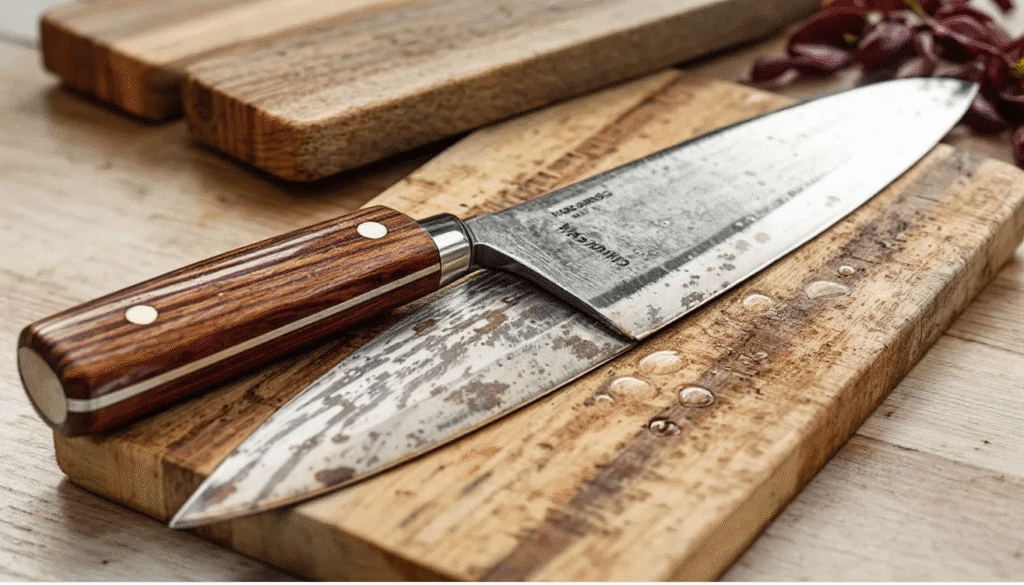
Taking care of a Masamoto knife is simple but important. Since the white steel isn’t stainless, it’s best to wipe the blade dry after each use to prevent rust. Patina may form over time, which is normal and can even add character to the blade. Avoid leaving the knife soaking in water or cutting acidic foods for long periods.
When it comes to sharpening, a whetstone is your best friend. Masamoto knives are designed to be easy to sharpen, so regular maintenance will keep your blade performing at its best. Sharpening at the right angle and following the blade’s grind pattern ensures the edge stays sharp and lasts longer. Keeping your knife properly sharpened is essential for maintaining cutting performance and prolonging the life of the blade.
The Masamoto KS Series: A Closer Look
The KS series is Masamoto’s premium line, made with Shirogami White Steel #2. These knives get extra attention during forging, polishing, and sharpening, making them some of the sharpest and most refined knives available. The series offers different blade sizes and styles, so you can find the best knife for your cooking needs.
One cool feature is the option for custom handles and saya (sheath) that fit snugly without needing pins. This adds a personal touch and protects the blade when not in use. Whether you’re a pro or a home cook, the KS series brings a professional feel to your kitchen.
Why Chefs Choose Masamoto
Professional and celebrity chefs pick Masamoto knives because they deliver consistent performance. The knives feel balanced and comfortable, which helps reduce hand strain during long prep times. The sharpness and durability mean chefs can rely on their tools without worrying about dull edges slowing them down.
Chefs also appreciate the refined finish and traditional craftsmanship that go into each knife. It’s not just about function; it’s about having a tool that connects with the cooking process and helps make great dishes. Masamoto knives have earned their spot in kitchens around the world for these reasons.
Tips for Getting the Most Out of Your Masamoto Knife
To keep your Masamoto knife in top shape, use it on the right cutting surface. Wood and quality plastic boards help protect the blade, while hard surfaces like glass or stone can cause damage. Avoid cutting through bones or frozen foods, as this can chip the edge.
Sharpen regularly with a whetstone to maintain the blade’s sharpness. When storing, keep the knife dry and use a sheath or knife block to protect the edge. How you store your Masamoto knife is crucial—proper storage helps maintain its quality and longevity, just as the brand’s flagship store in Tokyo has preserved its tradition and authenticity for over a century. With proper care, your Masamoto knife can last for years, continuing to deliver excellent cuts and a great cooking experience.
Where to Buy and Personalize Your Masamoto Knife
Masamoto knives are available through specialty kitchen stores and online retailers. Some sellers offer engraving options, so you can add a personal touch to your knife. Whether it’s your name or a special message, engraving makes your knife unique and can be a meaningful gift for a cooking enthusiast.
If you’re buying your first Masamoto knife, check the seller’s website for details on models, sizes, and customization options. Knowing what suits your cooking style will help you pick the right knife from their wide range.
Final Thoughts on Masamoto Knives
Masamoto knives combine tradition, quality, and performance in a way that few other brands can match. Their long history and dedication to craftsmanship show in every blade. Using a Masamoto knife means working with a tool designed for precision, durability, and comfort.
Whether you’re a professional chef or someone who loves cooking at home, these knives offer a reliable and enjoyable cutting experience. With the right care, a Masamoto knife will be a trusted kitchen companion for many years to come.
Thanks for reading! If you want to get your hands on a Masamoto knife, remember to choose the one that fits your needs and take good care of it. Happy cooking!
FAQs
Are Masamoto knives good for beginners?
Yes! Masamoto knives are sharp and well balanced, which helps you cut with less effort. They feel natural in your hand, so even if you’re new to cooking, they make chopping and slicing easier. Just remember to use a proper cutting board and keep the knife dry after use.
How do I keep my Masamoto knife sharp?
The best way is to sharpen it regularly with a whetstone. Follow the blade’s angle and grind pattern to keep the edge sharp. It’s easier than you might think, and doing this will help your knife last a long time.
Can I use a Masamoto knife on any cutting surface?
Try to stick with wood or good quality plastic boards. Hard surfaces like glass or stone can hurt the blade and make it dull faster. Using the right surface keeps your knife sharp and ready for the next meal.
